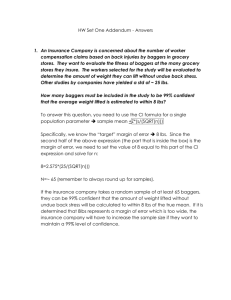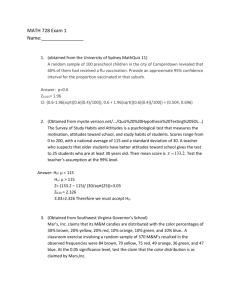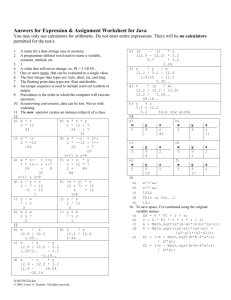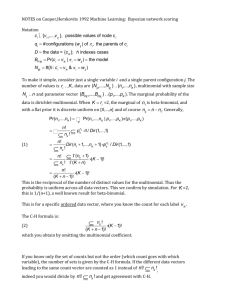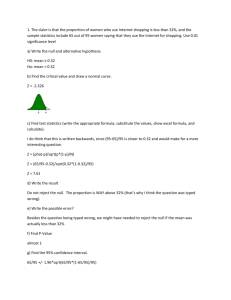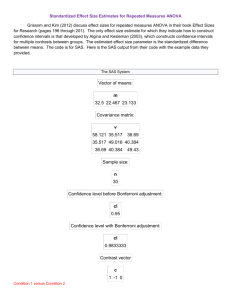Confidence Interval for Standardized Difference Between Means
advertisement
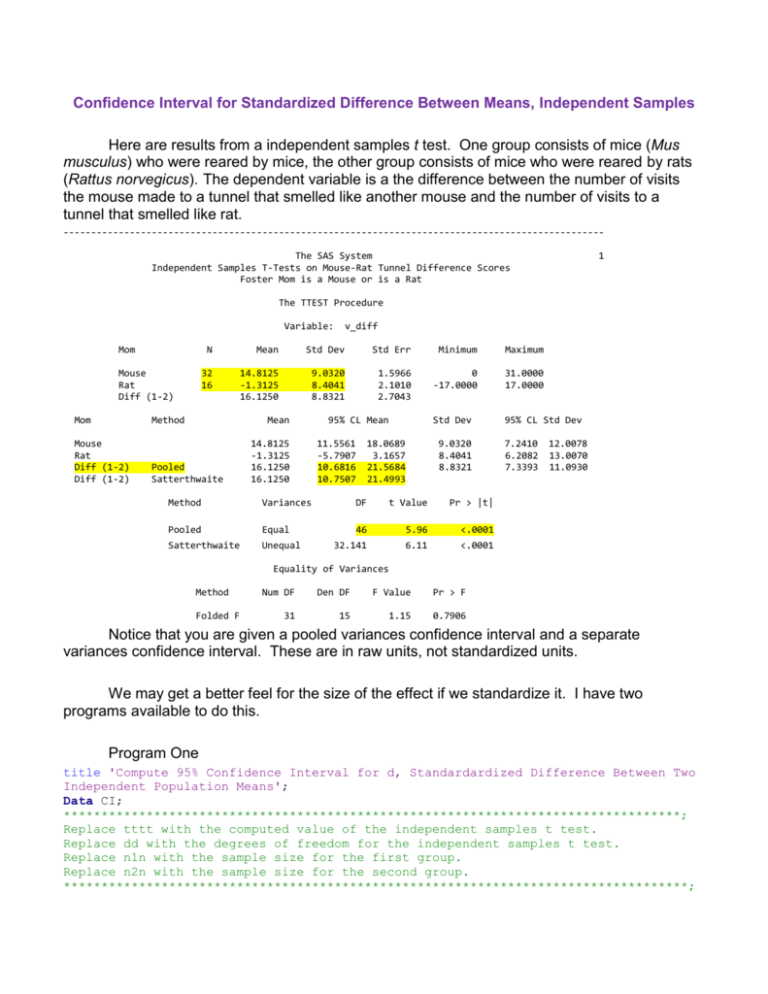
Confidence Interval for Standardized Difference Between Means, Independent Samples Here are results from a independent samples t test. One group consists of mice (Mus musculus) who were reared by mice, the other group consists of mice who were reared by rats (Rattus norvegicus). The dependent variable is a the difference between the number of visits the mouse made to a tunnel that smelled like another mouse and the number of visits to a tunnel that smelled like rat. -------------------------------------------------------------------------------------------------The SAS System Independent Samples T-Tests on Mouse-Rat Tunnel Difference Scores Foster Mom is a Mouse or is a Rat 1 The TTEST Procedure Variable: Mom Mouse Rat Diff (1-2) Mom N Mean Std Dev Std Err Minimum Maximum 32 16 14.8125 -1.3125 16.1250 9.0320 8.4041 8.8321 1.5966 2.1010 2.7043 0 -17.0000 31.0000 17.0000 Std Dev 95% CL Std Dev Method Mouse Rat Diff (1-2) Diff (1-2) v_diff Mean Pooled Satterthwaite 14.8125 -1.3125 16.1250 16.1250 Method Variances Pooled Equal Satterthwaite Unequal 95% CL Mean 11.5561 -5.7907 10.6816 10.7507 18.0689 3.1657 21.5684 21.4993 DF 9.0320 8.4041 8.8321 t Value 7.2410 6.2082 7.3393 12.0078 13.0070 11.0930 Pr > |t| 46 5.96 <.0001 32.141 6.11 <.0001 Equality of Variances Method Folded F Num DF Den DF F Value Pr > F 31 15 1.15 0.7906 Notice that you are given a pooled variances confidence interval and a separate variances confidence interval. These are in raw units, not standardized units. We may get a better feel for the size of the effect if we standardize it. I have two programs available to do this. Program One title 'Compute 95% Confidence Interval for d, Standardardized Difference Between Two Independent Population Means'; Data CI; **********************************************************************************; Replace tttt with the computed value of the independent samples t test. Replace dd with the degrees of freedom for the independent samples t test. Replace n1n with the sample size for the first group. Replace n2n with the sample size for the second group. ***********************************************************************************; t= 5.96 ; df = 46 ; n1 = 32 ; n2 = 16 ; ***********************************************************************************; g = t/sqrt(n1*n2/(n1+n2)); ncp_lower = TNONCT(t,df,.975); ncp_upper = TNONCT(t,df,.025); d_lower = ncp_lower*sqrt((n1+n2)/(n1*n2)); d_upper = ncp_upper*sqrt((n1+n2)/(n1*n2)); output; run; proc print; var g d_lower d_upper; run; The Output Obs g d_lower d_upper 1 1.82487 1.11164 2.52360 Notice that both sides of the confidence interval indicate that the effect is quite large. Program 2 *This program computes a CI for the effect size in a between-subject design with two groups. m1 and m2 are the means for the two groups s1 and s2 are the standard deviations for the two groups n1 and n2 are the sample sizes for the two groups prob is the confidence level; *Downloaded from James Algina’s webpage at http://plaza.ufl.edu/algina/ ; data; m1=14.8125 ; m2= -1.3125 ; s1=9.032 ; s2=8.4041 ; n1=32 ; n2=16 ; prob=.95; v1=s1**2; v2=s2**2; pvar=((n1-1)*v1+(n2-1)*v2)/(n1+n2-2); se=sqrt(pvar*(1/n1+1/n2)); nchat=(m1-m2)/se; es=(m1-m2)/(sqrt(pvar)); df=n1+n2-2; ncu=TNONCT(nchat,df,(1-prob)/2); ncl=TNONCT(nchat,df,1-(1-prob)/2); ll=(sqrt(1/n1+1/n2))*ncl; ul=(sqrt(1/n1+1/n2))*ncu; output; proc print; title1 'll is the lower limit and ul is the upper limit'; title2 'of a confidence interval for the effect size'; var es ll ul; run; The Output ll is the lower limit and ul is the upper limit of a confidence interval for the effect size Obs es ll ul 1 1.82572 1.11239 2.52453 2 The minor differences between these results and those shown earlier are due to rounding error from the value of t. Do it with SPSS Wuensch’s Stats Lessons Karl L. Wuensch, East Carolina University, Dept. of Psychology, 3. September, 2011.


